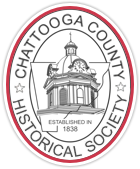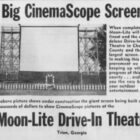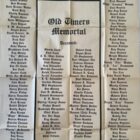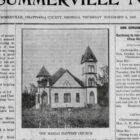Reminiscing about Trion’s Big Friendly Store in the 1940’s and 50’s
Memories by the late Gene Massey from his book
Our Father God, The Chili Wagon and the Finger Coffin
Memories of Life in Trion During the Forties and Fifties

The Trion Company Store decked out for the E award celebration the the mill received for excellent war production efforts in 1943.
At the end of the picturesque, horseshoe-shaped plaza was a large, square, two-story brick and white stucco-finished construction that was arguably the activity center of Trion. It was here that workers congregated at shift-change time and families and friends met for fellowship, shopping, and treats. It was a once upon a time place that we fondly called the store, and it was to Trion everything and more than everything and more than Rich’s was to Atlanta. We never referred to Trion’s shopping and social hub by its formal name; it was “the store” and it referenced a place and culture uniquely dedicated to serving the needs of local families! The formal name of this legendary community institution was The Trion Department Store, which later morphed into The Big Friendly. The square brick and stucco structure was surrounded by paved roads and sidewalks, but is was a noisy location because of the sounds made by looms in the adjacent weave shop. The shoe shop, dry cleaners and jail were located just southwest of the store on 10th Street which led up to Happy Top. The back and side of the store contained three entrances, one through the hardware department. one near the center of the stairs adjacent to the freight elevator, and one through the cafe. At times there was an unsavory odor at the entrance near the freight elevator, because it was near the trash building where old produce was thrown away. I also remember seeing caskets loaded onto the freight elevator so that they could be transported to the second floor and the “funeral parlor” and seeing them always gave me a spooky feeling. Early on, there was one room at the back of the store where dried corn was ground into cornmeal. This service was only available for a few hours each week. There was also an ice plant in the rear of the store, and in earlier years a horse-drawn wagon daily wound along the town’s dirt streets selling ice, prior to the advent of electric refrigerators. On warm summer days, we would approach the wagon and ask for a chip of ice, and the drivers nearly always accommodated us. The ice rested on a straw bed and was covered with canvas to retard melting.
The two main entrances to the store were located on the front facing the plaza area. There was a recessed double door central entrance that connected to the wide center aisle and the steps that led to the second floor.. There was a second double door front entrance adjacent to the soda fountain and drug department with magazines and books on the immediate right just inside the door. (Picture shows the “glove mill girls” going to lunch at the store. Read “Maurene Wallin remembers the Trion Glove Mill “, another article on this website.)
They Y shaped stairwell in the rear center of the store was adjacent to the freight elevator and back entrance to the store. The stairs went to a common landing and then branched into opposing stairwells, both of which led to the mezzanine or second floor level. There was a waist high wooden bannister around the center opening on the second floor that allowed folks to look through and see most of the first floor. The famous bargain loft, where locally manufactured cloth was sold at wholesale prices, was located on the southwest side of the mezzanine. People cam from other towns to take advantage of the cloth sales. I remember the black and chrome cloth meters with white dials that were used to measure the amount of cloth a person wanted from a given bolt and dress patterns and other sewing necessities were also sold in the department. The front section of the mezzanine at the Big Friendly contained offices and the accounts department. Since folks could charge purchases, they went to see Miss Polly Bohannon to cash checks and make payments on their accounts. Miss Polly and her trademark green visor were fixtures at the store for many years
The hardware department was managed by Tip McCollum. The room was filled with tools, lawnmowers, sporting equipment, wheelbarrows and all kinds of nails, screws and nuts and bolts.Tip was always willing to order anything that was not in stock, and he was the proprietor when the legendary Schwinn Black Phantom Bicycle was for sale..

The men’s ready-to-wear department was managed by Ralph Tribble who worked at the store for 25 years.
Lighting for all departments was via schoolhouse white glass fixtures suspended from the ceiling. The soda fountain also had ceiling fans. Most of the wooden counters in the variety department had top display areas that were divided by glass partitions into an assortment of shapes and sizes to accommodate the various items. The price for items was attached to the glass by a small metal clip.
Some of my favorite memories are associated with Carliss Buice who was also my Sunday School teacher at the Methodist Church. Whenever I wanted to buy candy, I always waited until he was behind the counter because I knew my dime would not buy much if anyone else waited on me. When I caught him behind the counter, I would ask for a dime’s worth of chocolate fudge, which was my favorite. He would always smile and talk for a minute before placing what to me was an enormous chunk of fudge on the scale as a prelude to slipping it into a bag. About once a year, a Philippino, who was advertised as the world champion yo-yoer, came to the store as a representative of the Donald F. Duncan Yo-Yo Company. He carved designs on the wooden fixed axle toys and we all dreamed of having a jeweled tournament model made of hard rock maple like the one he used. Yo-Yo strings, which broke often because we allowed our yo-yos to “hesitate” at the bottom of the down cycle, were sold 3 for a nickel at the tobacco counter which was located just left of the entry door nearest the barber shop. They came in small waxed paper envelopes.
Within the Big Friendly, was what we generically referred to as the drug store also contained the soda fountain, cosmetics, cameras, books and magazines, comic books, tobacco products, yo-yo strings and medications. Prescriptions were filled by Dr. John Rose whose wife was an outstanding teacher at the grammar school. Herman Haygood was also a pharmacist at one time and others included Brick Mason, Bob McWilliams and Walt Mason. The pharmacy was located just west of the soda fountain and non prescriptions medications and first aid supplies were also available. Cosmetics and cameras were displayed in glass fronted counters between the tobacco and drug areas. It was here that I first saw the fixed focus Anscoflex Twin Lens Reflex Camera and it was this special Christmas present for which I shamelessly begged. The soda fountain was extraordinary because of the tasty concoctions meticulously prepared. There was a pale green, three-station Waring blender that was used to make sumptuous milkshakes from fresh milk, vanilla flavoring and either vanilla, chocolate or strawberry ice cream. Fresh syrups, nut and cherries were kept store in stainless steel containers with small dippers whose handles extended through cut outs in the lids. There were also root beer and coke floats and malted milk, but my favorites were the fountain drinks made from syrup and carbonated water. Cokes were strong and had enough “bite” to sting the mouth and tongue. My absolute favorite was Fowler’s Cherry Smash! I do not know what became of this delectable beverage, but I remember the wine-colored glass syrup dispenser that sat on the counter near the fountain Coke machine. There were circular tables adjacent to the soda fountain where we could sit with friends or family members while enjoying fountain treats or we could just visit without buying anything. The table tops were made of thick glass which formed the tops of shadow boxes that were about five inches deep. Cosmetics and other items were artfully displayed inside the tables and within display cases in the center of the drug department. Each table also contained a napkin holder and a heavy glass straw container.
The grocery department was headed by Frank Scoggins and later Ross Arden Originally the grocery department was located in the northwestern corner of the store before being moved to the left front adjacent to the grey mill. The meat market was a separate room at the back of the grocery department and it had a tile floor, separate winging doors and gleaming white porcelain display cases that contained glass windows. Tom Day was manager and I believe this area may have been air conditioned earlier than the rest of the store. Ultimately, large air conditioning units that were approximately six feet tall and four feet wide were strategically placed and installed throughout the store, and it became an even more popular respite for folks during the summertime because none of the houses were air conditioned. It beckoned to shoppers and those waiting for their work shifts to begin! Many of the the folks who worked at the store evolved through a variety of experiences and departments before reaching their ultimate positions. The practice was to promote from within, and this made shoppers more comfortable with the clerks. Employees like Tip McCollum, Carl Baker and Roy Bruce all moved through a succession of jobs.
A watch repair shop manned by Homer McWhorter was located just to the left of the stairs that led to the second floor. Homer used a monocular type magnifying glass that was attached to a band that fit around his head. When he need to look at the internal workings of a watch, he pulled the magnifying ocular down so he could inspect or work on the watch. The mechanical watches of the day often required service and were repaired or cleaned rather than discarded.
The furniture department was managed by Jake Hegwood for 20 years. He sold furniture, appliances and luggage, and I still have one of the brown Samsonite suitcases I bought from him just before going to the University of Tennessee in the fall of 1956. Jake meticulously applied my initials to the luggage and the “quick tripper” is still decorated with beautiful rocky top decals!. Joe Sam Ray also worked in the furniture department and was the one who delivered and installed furniture and appliances.
There was a “beauty shop” where Kathleen Maddux worked as a beautician. The shop contained a number of “hornet nest ” dryers. I believe it occupied the space formerly used for mortuary services. Mortuary services were discontinued with the advent of more funeral homes. In essence, a person could be born, educated live, work and die in Trion without ever having to own a car or leave town.
There were two additional services that the store provided to the community. Each day, a large white bus with specially constructed body drove slowly through all the streets in Trion. The sign on the side read TRION DEPARTMENT STORE, but to us it was the “rolling store.” Each morning it was loaded with fresh vegetables, fruit, drinks, bread, candy and meats, and then at about the same time each day the vehicle’s horn sounded its arrival as it meandered down each street. Folks actually climbed aboard to select items they wanted. Patrons could even submit lists of groceries and have them delivered to their homes later in the day.
Trion was a special place in the 1940’s and 50’s and the store was a legendary part of that tranquil setting, contented lifestyle and those happy times. Those visitors who paused to view the grandeur of local institutions and visit places like the tavern, dairy and store must have been impressed and they would have known that the company that created them cared about the welfare of its people. Unlike Brigadoon, the magical Scottish town that became visible only one day every hundred years, Trion and the Big Friendly cast their magical spell each day of the year!



















